Antibody data
- Antibody Data
- Antigen structure
- References [2]
- Comments [0]
- Validations
- Western blot [2]
- Immunocytochemistry [1]
- Immunohistochemistry [1]
- Other assay [4]
Submit
Validation data
Reference
Comment
Report error
- Product number
- PA5-27288 - Provider product page

- Provider
- Invitrogen Antibodies
- Product name
- BMP-4 Polyclonal Antibody
- Antibody type
- Polyclonal
- Antigen
- Recombinant full-length protein
- Description
- Recommended positive controls: HepG2 conditioned medium, NIH-3T3, JC. Predicted reactivity: Mouse (97%), Rat (96%), Dog (97%), Pig (98%), Rabbit (96%), Sheep (98%), Bovine (97%). Store product as a concentrated solution. Centrifuge briefly prior to opening the vial.
- Reactivity
- Human
- Host
- Rabbit
- Isotype
- IgG
- Vial size
- 100 μL
- Concentration
- 0.34 mg/mL
- Storage
- Store at 4°C short term. For long term storage, store at -20°C, avoiding freeze/thaw cycles.
Submitted references Consecutive Hypoxia Decreases Expression of NOTCH3, HEY1, CC10, and FOXJ1 via NKX2-1 Downregulation and Intermittent Hypoxia-Reoxygenation Increases Expression of BMP4, NOTCH1, MKI67, OCT4, and MUC5AC via HIF1A Upregulation in Human Bronchial Epithelial Cells.
Nano-Polyplexes Mediated Transfection of Runx2-shRNA Mitigates the Osteodifferentiation of Human Valvular Interstitial Cells.
Yang YY, Lin CJ, Wang CC, Chen CM, Kao WJ, Chen YH
Frontiers in cell and developmental biology 2020;8:572276
Frontiers in cell and developmental biology 2020;8:572276
Nano-Polyplexes Mediated Transfection of Runx2-shRNA Mitigates the Osteodifferentiation of Human Valvular Interstitial Cells.
Voicu G, Rebleanu D, Constantinescu CA, Fuior EV, Ciortan L, Droc I, Uritu CM, Pinteala M, Manduteanu I, Simionescu M, Calin M
Pharmaceutics 2020 Jun 2;12(6)
Pharmaceutics 2020 Jun 2;12(6)
No comments: Submit comment
Supportive validation
- Submitted by
- Invitrogen Antibodies (provider)
- Main image
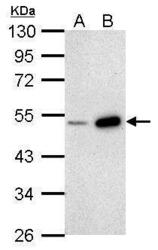
- Experimental details
- Western Blot using BMP-4 Polyclonal Antibody (Product # PA5-27288). Sample (30 µg of whole cell lysate). Lane A: NIH-3T3. Lane B: JC. 10% SDS PAGE. BMP-4 Polyclonal Antibody (Product # PA5-27288) diluted at 1:1,000. The HRP-conjugated anti-rabbit IgG antibody was used to detect the primary antibody.
- Submitted by
- Invitrogen Antibodies (provider)
- Main image
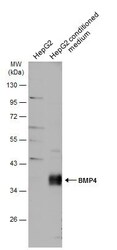
- Experimental details
- Western blot analysis of BMP-4 was performed by separating 30 µg of HepG2 whole cell extract and conditioned medium by 10% SDS-PAGE. Proteins were transferred to a membrane and probed with a BMP-4 Polyclonal Antibody (Product # PA5-27288) at a dilution of 1:500. The HRP-conjugated anti-rabbit IgG antibody was used to detect the primary antibody.
Supportive validation
- Submitted by
- Invitrogen Antibodies (provider)
- Main image
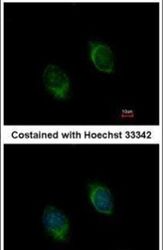
- Experimental details
- Immunofluorescent analysis of BMP4 in methanol-fixed HeLa cells using a BMP4 polyclonal antibody (Product # PA5-27288) at a 1:100 dilution.
Supportive validation
- Submitted by
- Invitrogen Antibodies (provider)
- Main image
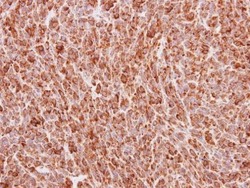
- Experimental details
- Immunohistochemical analysis of paraffin-embedded MDA-MB468 xenograft, using BMP4 (Product # PA5-27288) antibody at 1:100 dilution. Antigen Retrieval: EDTA based buffer, pH 8.0, 15 min.
Supportive validation
- Submitted by
- Invitrogen Antibodies (provider)
- Main image
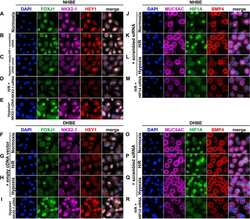
- Experimental details
- NULL
- Submitted by
- Invitrogen Antibodies (provider)
- Main image
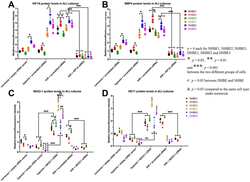
- Experimental details
- NULL
- Submitted by
- Invitrogen Antibodies (provider)
- Main image
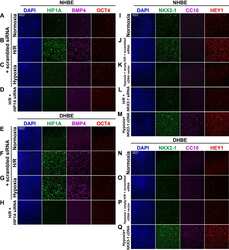
- Experimental details
- NULL
- Submitted by
- Invitrogen Antibodies (provider)
- Main image
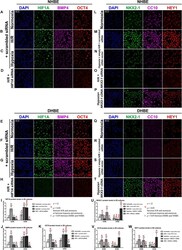
- Experimental details
- FIGURE 9 Colocalization and concordant regulation of the immunofluorescence signals of HIF1A, BMP4 and OCT4 proteins, and of the immunofluorescence signals of NKX2-1, CC10 and HEY1 proteins in both undifferentiated NHBE and DHBE cells. (A-H) Triple immunofluorescence staining for HIF1A (green), BMP4 (magenta), and OCT4 (red) in the submerged cultures of undifferentiated NHBE cells (A-D) and DHBE cells (E-H) revealed colocalization of HIF1A, BMP4 and OCT4 proteins in the same HBE cells. (I-K) Statistical charts showing concordant upregulation of the immunofluorescence intensities of HIF1A, BMP4 and OCT4 proteins by intermittent H/R in both the NHBE and DHBE cells. (L-T) Triple immunofluorescence staining for NKX2-1 (green), CC10 (magenta) and HEY1 (red) in the submerged cultures of undifferentiated NHBE cells (L-P) and DHBE cells (Q-T) revealed colocalization of NKX2-1, CC10 and HEY1 proteins in the same HBE cells. (U-W) Statistical charts showing concordant downregulation of the immunofluorescence intensities of NKX2-1, CC10, and HEY1 proteins by consecutive hypoxia in both the NHBE and DHBE cells. The scale bars in (A,E,L,Q) all represent 50 mum and respectively apply to panels (A-H,L-T) .
 Explore
Explore Validate
Validate Learn
Learn Western blot
Western blot